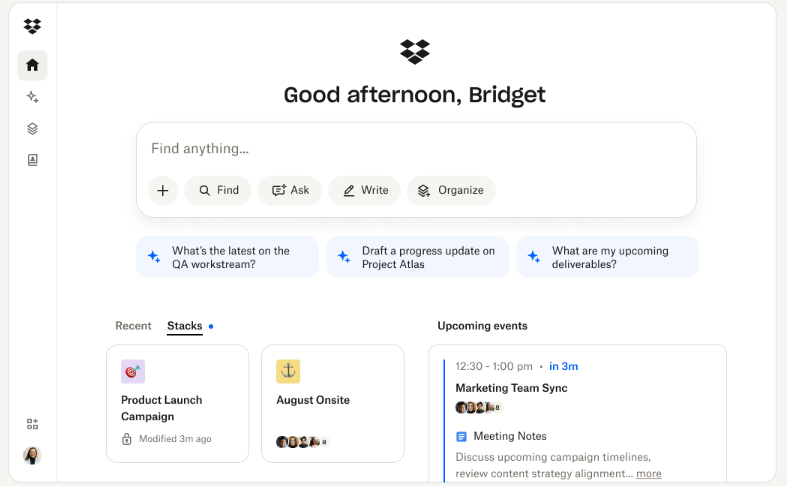
People have so much data, and yet still can’t find the file they need.
We’ve got more content than ever—but actually finding the right file, message, or insight when you need it is still surprisingly hard. The answer is obviously not to just store more.
Traditional systems are great at storing data. However, most fall short when it comes to retrieving it efficiently, especially in fast-paced work environments where content is scattered across cloud platforms, email, and apps.
Effective information retrieval systems can improve this and help avoid other challenges too. In this guide, we’ll break down what information retrieval really means, how these systems work, and why they’re essential for any business looking to work better with their company knowledge.
It doesn’t matter if you’re new to the concept or brushing up to make the right decision, you’ll leave with a clearer understanding of how better search can lead to better business outcomes.

What is information retrieval?
At its core, information retrieval (IR) is the process of finding useful information from a large pool of data—whether that’s a search engine scanning billions of web pages or a business tool pulling up a specific contract from shared cloud storage.
Following this, an information retrieval system is any technology built to perform this task. It indexes content, understands queries, and serves up results that (ideally) match what the user actually needs.
Here’s the key difference between basic search and true IR—traditional search matches keywords while information retrieval understands intent.
In modern digital workplaces, where data lives across multiple platforms and project tools, IR systems go beyond looking at text and consider search context, relationships between documents, and what users are really asking for.
This shift from simple matching to intelligent understanding is what’s under the hood of modern AI-driven search. It means your team can ask “Where’s the final version of the ad copy?” and actually get the right answer.
Whether you're working in IT, operations, or knowledge management, understanding how IR systems work gives you a big-picture view of how better search and retrieval is shaping the future of productivity.
How do information retrieval systems work?
Unless you’re deep in a computer science course, you probably don’t need a lecture on inverted indexes, Boolean models, and other concepts. So we’ll keep this simple.
At a high level, information retrieval systems follow a few key steps to help you find what you’re looking for quickly and accurately. Here’s how it works generally in a few steps:
1. Indexing content
Think of this like building a table of contents. The system scans your data—files, emails, messages, documents—and creates a map so it knows what’s where.
This map is a content index, which is kind of like a shortcut to looking up relevant information quickly. The index is the reason that your information can be retrieved in a flash when using the right tools.
2. Matching queries with relevant content
When someone searches, the system doesn’t just scan titles. It looks at the full body of content to find the files, threads, or notes most closely related to the search terms and what they seem to mean.
The system looks into files, whether that’s a clause in a PDF contract or a tiny note in a feedback document, and takes it into consideration when surfacing your query results.
3. Understanding natural language
Today’s IR systems go beyond matching keywords. Ask, “Where’s the latest QA checklist?” and the system understands it’s looking for a document related to quality checks—not just something titled “QA checklist”.
The benefits of having a system that can understand context include more accurate results, faster, and with a greater impact on efficiency within a team. This means you don’t have to rely on keywords to make search work.
4. Learning from usage patterns
The more your team uses the system, the smarter it gets. It starts to recognize patterns—like which documents are most commonly accessed together—and surfaces them accordingly.
This evolution is what makes the system truly smart. The usual search system, using an algorithm, doesn’t develop over time and has limitations that often lead to surfacing poor results.
5. Ranking results by relevance
Instead of showing files alphabetically or by date, smart systems prioritize what’s most useful. That might be the most viewed document, the one you used last week, or the file with the most related keywords and context.
Finding the most useful files for an individual or team is more efficient and easier for the people doing the work. This helps employees keep working without stopping or searching too much.
So what does that look like in the real world?
You can probably imagine the benefits of perfectly indexed and accessible content. Here’s how that plays out across different teams:
- Marketing and creative: Instantly pull up the final brand asset, campaign brief, or content plan—without sifting through layers of drafts, emails, or misnamed folders.
- Sales: Find the latest pricing sheet, product summary, or case study during a call—without changing tabs or asking teammates for links. It’s a great benefit for fast-paced work environments that need to drive forward.
- IT: Need a security policy or access log stored across three platforms? A good retrieval system helps you locate it in seconds—without the tab-juggling. IR can make a lot of intricate or complex needs much simpler.
- HR: No more looking through shared drives for an onboarding checklist or updated handbook. IR makes it searchable across Slack, Dropbox, or your HR platform—so you’ll always have quick access to the latest details.
- Legal: Find historical contracts, look for hard-to-spot legal redlines, or policy language—even if they’re buried in old email threads, folders, or somewhere random.
- Ops: Surface SOPs, meeting notes, or process documentation without playing guessing games with file names.
Faster answers, fewer interruptions, and better-informed teams. That’s the power of IR in a world where content lives everywhere.
See information at a glance
The handy start page in Dash can provide information on all your most recent files and activity at a glance.
4 benefits of information retrieval systems for business
Information retrieval is a major enabler of productivity, alignment, and data security across your organization.
Whatever your role, if you’re tired of answering the same questions every week, here’s how IR systems can help:
1. Less time hunting, more time doing
Instead of clicking through inboxes, tabs, or endless folders, employees can search once and get straight to what they need. That’s hours reclaimed each week across teams. Better search means better focus and more attention in the areas that really matter.
2. Information, in context
Effective retrieval systems don’t simply return files. They group related content, recognize patterns, and surface documents when and where they’re most useful. If you’ve ever had the feeling of not knowing where a file is, you can get accurate results when looking at related content in your system.
3. Better collaboration across tools
When everyone’s working in different apps, things get lost in the mix. However, IR systems make content discoverable across platforms. For example, you could search both Slack and your company’s marketing tools at the same time. This means your team can stay aligned, even if their tools differ.
4. Built-in security, less exposure
A great information retrieval system knows who should see what and who shouldn’t. By respecting existing permissions and keeping sensitive content behind access controls, IR helps reduce the risk of accidental data exposure.
Overall, a reliable information retrieval system makes your business data faster to access, more secure, and easier to navigate. Whether onboarding or making a key decision, having the right information has a big impact.
Dropbox Dash: An information retrieval solution for the way teams actually work
If you’re looking for a tool that brings the benefits of information retrieval systems to life, Dropbox Dash is a solid option—designed to help navigate today’s complex, cross-platform work environment.
Dash combines AI-powered universal search with human-like answers about your data in Chat. Whether you’re trying to find the final version of a file, an old document buried in email threads, or important notes dispersed across multiple platforms, Dash brings everything together in one searchable workspace.
It also respects your existing file permissions, provides visibility through an intuitive admin console, and lets you manage knowledge securely at scale—no steep learning curve required.

Frequently asked questions
What is an example of information retrieval?
It’s all about surfacing the right content from a sea of data. A simple example is searching your inbox for a client proposal and having it pop up in the top results. On a broader scale, information retrieval powers things like search engines or internal data management tools, which help employees find documents, emails, and project files across platforms.
What are the three types of information retrieval?
There are many types, which are typically of greater interest in the computer science field than when using an IR tool itself. While IR can take many forms, three common types include:
- Boolean retrieval—this is where you use operators (AND, OR, NOT, etc.) to narrow results
- Vector space retrieval—here, instead of exact matches, this ranks results based on how closely they relate to the query
- Probabilistic retrieval—this predicts how likely a file is to be relevant, based on past behavior or statistical models
Modern AI-powered tools often blend elements of all three before layering in natural language understanding—for even smarter results.
Is information retrieval the same as data querying?
Not quite. Data querying (like in SQL) is structured, which means you’re asking specific questions of a defined dataset. Information retrieval is broader—it’s about finding the best match from unstructured or semi-structured data. If querying is like choosing from a list of possible books, IR is more like asking a librarian for a recommendation and getting a personalized answer.
What are information retrieval skills?
These include a mix of both technical and practical abilities, such as:
- Knowing how to structure a search query effectively
- Understanding the tools your company uses to store and retrieve data
- Using filters, tags, and context to find what you need faster
- Evaluating whether the information you’ve retrieved is current, relevant, and complete
Overall, IR skills help you get better answers, faster—so you can spend less time searching and more time getting things done.
Use AI to speed up information retrieval
AI-powered information retrieval won’t replace your systems, but it will improve on existing systems. When your team is struggling with tools, tabs, and timelines, manually tracking down files just adds annoying drag.
That's where tools like Dropbox Dash are really helpful. Dash goes beyond information retrieval, using AI to understand what you need and show it to you quickly—without the hassle.
Explore Dropbox Dash and talk to our team to see how AI can streamline your information retrieval and power up your productivity.
Get started with Dash
.webp)

.svg)


